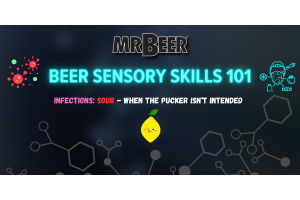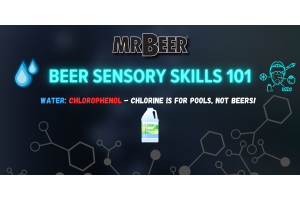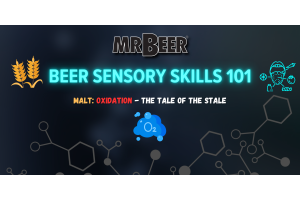Beer Sensory Skills 101 | Hops | Lightstrike
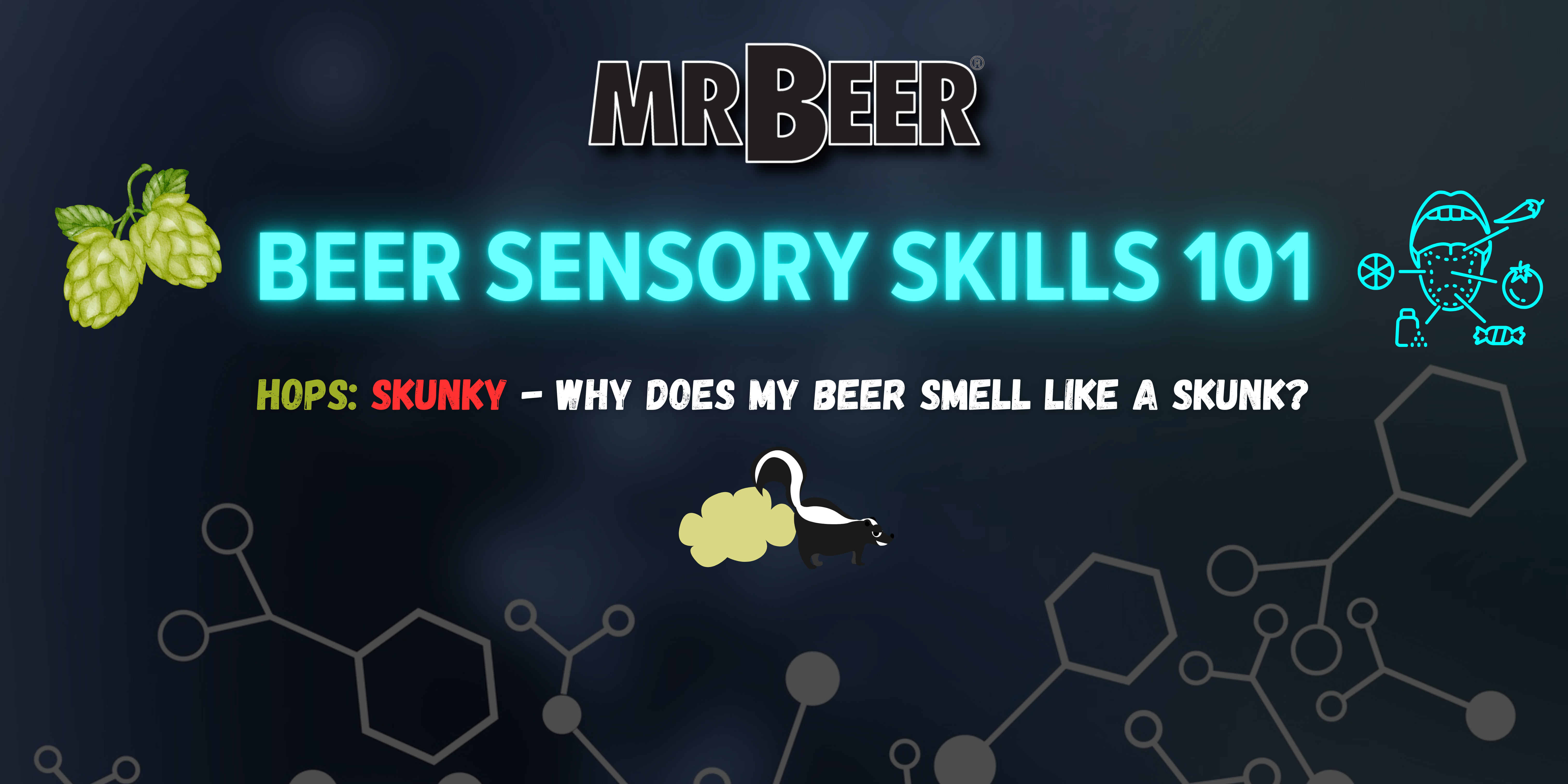
This article is part of a series of lessons and exercises that focus on enhancing your sensory skills to better recognize and address brewing problems. By training your sense of smell, taste, mouthfeel, etc., you will have a better understanding of identifying off-flavors/aromas and their causes, which can greatly assist you when looking for solutions to these problems. This blog series will come in many parts dealing with Yeast, Hops, Malt, Water, Infections/Contaminations, and Miscellaneous issues.
Each lesson includes an exercise in a separate tab to assist you in developing your palate and other senses to better detect these flavors, aromas, etc.
Lesson 2.1- Hops: Skunky - Why Does My Beer Smell Like A Skunk?
The Chemistry:
Lightstrike, also known as "skunking," is a chemical reaction that occurs in beer when certain compounds derived from hops are exposed to ultraviolet (UV) light, typically from sunlight. This reaction can significantly alter the flavor and aroma profile of the beer, often resulting in an unpleasant and distinctive "skunky" smell and taste.
The primary agents responsible for lightstrike are hop compounds called isohumulones, which are responsible for contributing bitterness to beer. These isohumulones are sensitive to light, particularly in the blue spectrum (around 350-500 nanometers), which is present in sunlight.
When beer is exposed to UV light, particularly in the blue range, the photons in the light interact with the isohumulones, causing them to undergo a photochemical reaction known as photoisomerization. During this process, the molecular structure of the isohumulones is altered, resulting in the formation of new compounds, notably 3-methyl-2-butene-1-thiol (MBT). It is this MBT compound that gives the characteristic skunky aroma and flavor to the beer.
The "Stink":
The skunky aroma is often described as similar to that of a skunk's spray, hence the term "skunking" for this phenomenon. It's important to note that this aroma is distinct from the natural aromas of hops and is generally considered undesirable in beer. However, you have most likely experienced this flavor/aroma profile in some popular bottled beers like Heineken, Corona, Beck's, Stella Artois, and Grolsch. It's also a common profile in malt liquors such as Mickey's, Olde English, etc.
What do all of these beers have in common? They are all bottled in green or clear glass, which won't protect the beer from the UV light that causes lightstrike. This is why most breweries bottle their beer in brown/amber glass. Of course, regarding the European beers I mentioned above, and despite what some American fans of those beers may think, those breweries never intended for their beers to "skunk" in that way. Unfortunately, it's a more common flavor profile in the US because of the time it takes for imported beer to arrive in our country. The extra logistics required for importing foreign beers significantly raises the risk of lightstrike, oxidation, or other undesirable issues in the beer. This is also why these beers always taste better when consumed in their home countries.
Many of these breweries have been taking steps in the recent years to mitigate occurences of lightstrike in their beer. For example, Heineken now cans most of their beer for export. They've also switched to brown glass for some of their products. Corona, Beck's, and Stella Artois have all made similar efforts to reduce lightstrike in their beer.
Avoiding Lightstrike:
As a homebrewer, there are several steps you can take to minimize the risk of lightstrike and preserve the quality of your beer:
• Use Dark Bottles: Similar to commercial breweries, using dark brown or amber glass bottles, provides better protection against UV light compared to clear or green bottles. This practice helps prevent lightstrike and preserve the flavor integrity of your beer. If you're reusing bottles, consider choosing dark bottles for storage. Alternatively, using PET plastic bottles, which are often brown or opaque, can also help reduce light exposure.
• Store Beer in a Dark Place: After bottling your beer, store it in a cool, dark place away from direct sunlight or artificial UV light sources. A cellar, closet, or cupboard are good options. Avoid storing your beer in areas where it's exposed to sunlight for extended periods, as even brief exposure can potentially lead to lightstrike.
• Limit Exposure to Light: When handling your beer, try to minimize its exposure to light as much as possible. Keep it covered with a cloth or towel when transferring it to and from storage locations, especially if you're moving it outdoors during brewing or bottling processes.
• Consider Packaging Methods: If you have the equipment and resources, consider investing in a kegging system. Beer stored in kegs is typically not exposed to light until it's poured into a glass, minimizing the risk of lightstrike.
• Monitor Storage Conditions: Regularly check the storage conditions of your beer to ensure it's not being exposed to light inadvertently. If you notice any changes in flavor or aroma, such as skunkiness, consider adjusting your storage methods accordingly.
• Be Mindful During Brewing and Bottling: While brewing and bottling your beer, take care to shield it from direct sunlight or artificial UV light sources. Use shaded areas or cover your fermenter with a dark cloth or blanket during fermentation and bottling to minimize light exposure.
By following these steps, you can help minimize the risk of lightstrike and preserve the quality of your homebrewed beer. Remember that even small amounts of light exposure can potentially lead to off-flavors, so it's essential to be vigilant about protecting your beer from light throughout the brewing and storage process.
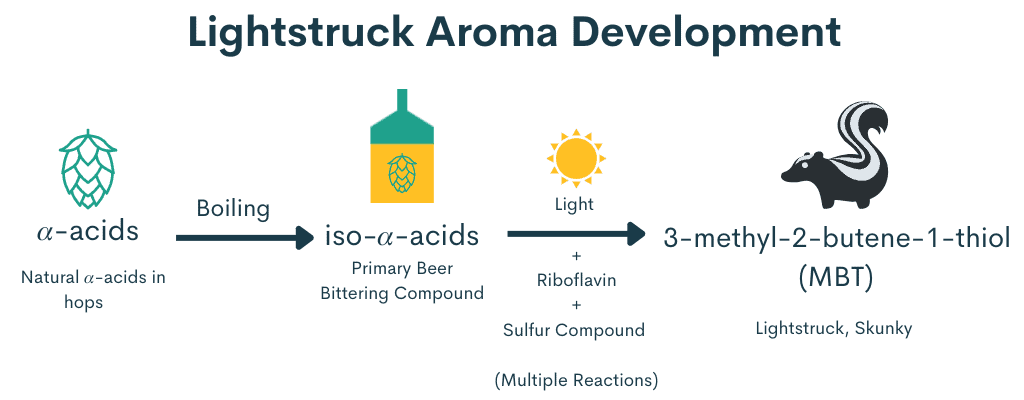
Detecting Autolysis
Aroma:
• Skunky Aroma: The most recognizable characteristic of lightstruck beer is its aroma, which is often described as reminiscent of the scent produced by a skunk's spray. This aroma can range from subtle to intense, depending on the degree of light exposure and the beer's susceptibility to lightstrike.
• Sulfury Notes: Lightstruck beer may also exhibit sulfury or sulfur-like notes, which contribute to the overall off-putting aroma. These sulfur compounds are byproducts of the chemical reactions that occur when hop compounds interact with UV light.
Flavor:
• Off-Flavors: In addition to the skunky aroma, lightstruck beer can develop off-flavors that detract from its overall taste profile. These off-flavors may include a stale or cardboard-like taste, which can further contribute to the perception of the beer as unpleasant.
• Loss of Freshness: Lightstruck beer may also lose its freshness and vibrancy, with the hop-derived flavors and aromas becoming muted or altered. Instead of showcasing the intended characteristics of the beer, such as hoppy or floral notes, lightstruck beer may taste dull and lackluster.
Overall, lightstruck beer is characterized by its skunky aroma, sulfury notes, and off-flavors, which can significantly detract from the drinking experience.
Sensory Training:
• Compare Beers: Purchase some Heinekens in green bottles and some in cans. The green bottles should taste much different and have a more "skunky" profile.
• Leave Some Beer Out in the Sun: You can do this as an experiment with your own homebrew, or you can purchase some commercial beers and try this. Acquire two bottles of the same beer, one of which has been intentionally exposed to sunlight for a period of time to simulate lightstrike, while the other has been kept in a dark environment. Conduct a side-by-side tasting of the two beers to compare their flavors and aromas. Take note of any differences in aroma, taste, and mouthfeel between the two samples.
• Blind Tasting: Prepare samples of various beers, including some that have been intentionally lightstruck and others that have not. Serve the samples to participants in opaque or covered glasses to ensure a blind tasting experience. Encourage participants to evaluate each sample and identify any off-flavors associated with lightstrike without knowing which samples have been exposed to light.
• Dilution Experiment: Dilute a lightstruck beer with a neutral-flavored beverage, such as water or a light lager, to reduce the intensity of the off-flavors. Prepare several dilutions with varying levels of concentration, ranging from undiluted to highly diluted. Taste each sample and note how the perception of the skunky aroma and flavor changes as the concentration of the off-flavors decreases.
By regularly engaging in these experiments and activities, homebrewers can develop their sensory skills and become more adept at detecting off-flavors, including those caused by lightstrike, in their beer. This heightened awareness can be invaluable for improving the quality of their homebrewed beer and refining their brewing techniques over time.


